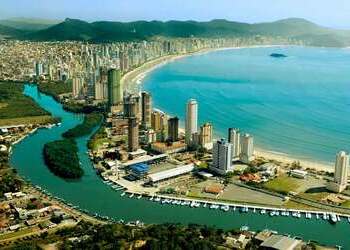Santa Catarina is a launchpad for cocaine destined for Europe and a transit point for marijuana and contraband headed to the Brazilian state of Rio Grande do Sul and Uruguay.
Criminal groups also produce and traffic synthetic drugs in the state, supplying the Brazilian drug market. Some of these drugs are imported from Europe.
Firearms enter the country from Paraguay. In recent years, this criminal economy has expanded due to competition between criminal groups.

Criminal Actors
Primeiro Grupo Catarinense (PGC): The Primeiro Grupo Catarinense is the largest criminal structure in Santa Catarina. The group dominates marijuana, cocaine and arms trafficking in the state and has also entered the synthetic drug market. The PGC has between 6,000 to 10,000 members throughout the state, but the group has not yet managed to exercise social control in the state capital of Florianópolis. Its structure is divided into two so-called ministries, made up of five and eight leaders respectively. The PGC’s factions are semi-autonomous and can dictate their own activities in their areas of influence. The group has the logistical capacity to smuggle in drugs from Paraguay, where it sends its emissaries to strategic regions.
Comando Vermelho (CV): There has been an alliance between the PGC and the CV for several years. However, no criminal actions from the Rio de Janeiro faction of the CV have been identified in Santa Catarina.
Primeiro Comando da Capital (PCC): The PCC is the PGC’s main criminal rival and Santa Catarina’s second most prominent criminal actor. The group has close to 500 members in the state. Of these, 80 percent are in jail, with the other 20 percent on the streets. Joinville and Chapecó are the main PCC strongholds in Santa Catarina. The group also controls drug trafficking in at least two favelas in Florianópolis. Beyond local drug-peddling, the PCC is seeking to establish control of the international cocaine routes passing through the state.
Criminal Economies
Arms Trafficking: Santa Catarina, like many other states in southern Brazil, is a major entry point for illegally smuggled firearms. The PCC and the PGC are among the main consumers of illicit weapons. The arms trafficking economy could reach into the millions of dollars annually, based on seizure data and black-market price estimates.
Cocaine: Brazil has become one of the most important cocaine export routes to Europe. Santa Catarina provides a convenient link between cocaine-producing countries and the Atlantic ports from where the drug is exported. An estimated 50 tons of cocaine are trafficked through Santa Catarina annually, worth hundreds of millions of dollars, making it a significant criminal economy in the state.
Cannabis: Brazil is one of the main consumers of marijuana in the region. Neighboring Paraguay is the main producer. Although Santa Catarina does not share a border with this country, much of the marijuana produced in Paraguay is trafficked into the state. This criminal economy is worth tens of millions of dollars annually.
Environmental Crime: In Santa Catarina, several endangered animal species are trafficked on the black market. Some of the most commonly trafficked animals are birds and reptiles. Still, it is a small criminal market, compared to its drug counterparts, valuing in the hundreds of thousands of dollars per year.
Human Trafficking: Santa Catarina is a tourist destination and an agricultural center, making it a fertile ground for sex and labor trafficking. However, there is minimal information on how human trafficking rings operate or on the size of this criminal economy in the state.
Human Smuggling: Some migrants use Santa Catarina as a transit point on their way to other countries, namely the United States. However, there is minimal information on how human smuggling groups operate in the state.
Mineral Resources: The state’s port, Itajaí, appears to be a transit point for illegal gold and other illegally-sourced minerals coming from the Amazon for export, or arriving from other parts of the world on their way into Brazil.
Contraband: Santa Catarina shares a border with Argentina, but compared to neighboring states, contraband flows are modest. Cigarette smuggling is a profitable criminal economy in the region, and Santa Catarina’s criminal groups appear to profit from the trade. Most cigarettes originate from Paraguay and reach Santa Catarina via Argentina or other Brazilian states.
Synthetic Drugs: The sale of synthetic drugs smuggled into Brazil from Europe is one of the most robust and profitable illicit economies in Santa Catarina. Synthetic drugs are also produced in the state. Santa Catarina houses a vibrant consumer market for this type of narcotics. It also supplies Brazil’s main cities. Cocaine sent from Santa Catarina to Europe is exchanged for MDMA and other synthetic drugs, which are sent back to Brazil. Once in Santa Catarina, drug rings cut the drug so that the pills only contain 10 percent of the initial drug. The synthetic drug market is controlled by specialized groups, as consumption is concentrated in higher social classes. Gangs such as the PCC and the PGC are just beginning to participate in this profitable economy. Brazilian drug traffickers have been arrested in Balneário Camboriú while allegedly transporting fentanyl. Criminal groups have also sourced this drug from public hospitals. Fentanyl is produced in China and smuggled into Brazil. However, it is not clear whether there is a significant consumption market in Santa Catarina, or if fentanyl is mainly sent from Brazil to the US.
Sources: This profile is based in a field investigation in Florianopolis, Santa Catarina, and two trips to São Paulo where InSight Crime interviewed representatives of the Attorney General’s Office, a national police investigation unit, a national anti-organized crime division, federal police, and local journalists, most of whom requested anonymity. InSight Crime also drew from information provided by Brazil’s Public Security Forum, O Globo, and local press.

